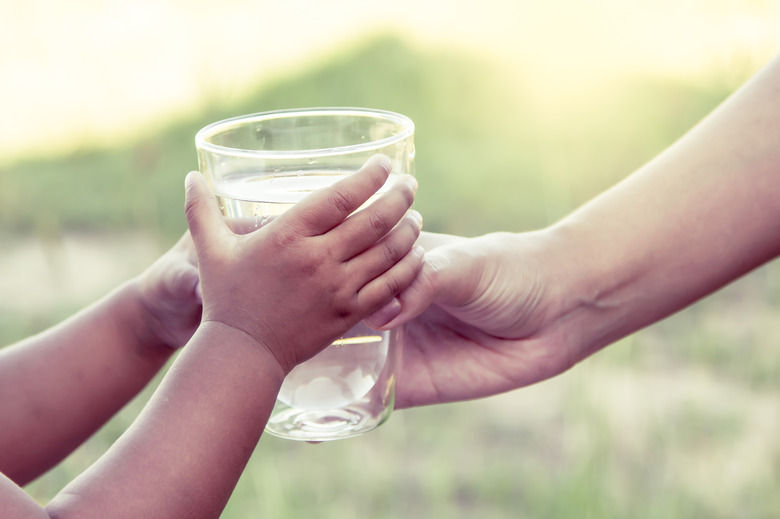The Effects Of Algae In Drinking Water
The impact of algae on clean drinking water is complex. Some forms of algae create challenges for water systems used by humans and animals by producing toxins that can have unpleasant, and even serious, health effects. Other types of algae are benign, and actually improve water quality.
TL;DR (Too Long; Didn't Read)
Algae can have a positive, neutral, or negative impacts on drinking water: it all depends on the type.
Green, Red or Brown Algae and Red Tides
Green, Red or Brown Algae and Red Tides
A type of phytoplankton called dinoflagellates—which are single-celled protists—can form large and harmful concentrations that damage water and can produce substantial quantities of toxins. A bloom of these organisms is called a red tide, and often occurs in warm waters, such as those in the Gulf of Mexico and the Gulf of Maine.
The impact of an algal explosion varies depending on the size and severity of the bloom, as well as the species of dinoflagellate. Toxins produced by these protists can poison fish and shellfish, and these toxins concentrate as they move up the food chain, potentially poisoning larger animals like dolphins, manatees, and even humans. Eating seafood contaminated with these toxins can be toxic or fatal to humans. One such toxin, domoic acid, is a neurotoxin: high concentrations of this compound have been reason enough to shut down fisheries. Neurotoxic shellfish poisoning, caused by brevetoxins, can occur with either ingestion or inhalation. Indeed, large enough blooms produce airborne toxins that can cause respiratory problems for beachgoers on the shore.
Though typically found in coastal areas, red tides can occur in freshwater as well, making them dangerous to drinking water supplies.
Blue-Green Algae and Cyanotoxins
Blue-Green Algae and Cyanotoxins
Though many types of algae are plants or plant-like organisms, blue-green algae are actually a kind of bacteria, known as cyanobacteria. Blue-green algae are unicellular photosynthetic organisms that can inhabit fresh- and saltwater, as well as damp soil and rocks. This kind of algae can be found almost everywhere on earth.
These little organisms can 'bloom' on the surfaces of bodies of water. Blooms of blue-green algae, most common in the hot summer months, can endanger drinking water supplies by producing toxins. When ingested, these toxins can cause illness and even death. Humans and animals swimming in (or drinking water from) bodies of water with blue-green algae can present with symptoms ranging from liver damage to paralysis.
The types and amounts of these poisons, or cyanotoxins, produced depend on the species of cyanobacteria and the size of the bloom. The U.S. Environmental Protection Agency has identified numerous toxins produced by certain types of blue-green algae. Ingested cyanotoxins that attack the liver can create abdominal pain, vomiting, diarrhea, an inflamed and bleeding liver, pneumonia or kidney damage and might even promote tumor growth. Another set of cyanotoxins attacks the nervous system and can cause tingling, numbness, a burning sensation, drowsiness, incoherence, paralysis or death. Skin contact with cyanotoxins can cause irritation of the skin, eyes, throat, nose or respiratory tract.
Blue-green algae isn't all bad, however. Some cyanobacteria—those that don't produce toxins—can actually improve the quality of bodies of water by converting carbon dioxide into oxygen and by making nitrogen available to plants, a process called nitrogen fixation. These actions support the growth of plants and the animals that eat them.
Algae in General: Helpful or Harmful?
Algae in General: Helpful or Harmful?
'Algae' is really a catch-all term for a polyphyletic assemblage of mostly aquatic photosynthesizing organisms. While category includes protists and cyanobacteria that can cause harmful algal blooms, it also includes seaweed and kelp, which help cleanse and balance marine ecosystems, and thus play a role in producing clean water.
Algae is everywhere: and although the vast majority of algae in drinking water is generally harmless, it's best to be on the safe side—wash filtered-water pitchers, camping water containers and pet bowls with bleach, and keep them out of the heat and sun to discourage algal growth. Steer clear of areas with harmful algal blooms, and always boil water from freshwater drinking sources.
Cite This Article
MLA
Finance, Eric Bank, MBA, MS. "The Effects Of Algae In Drinking Water" sciencing.com, https://www.sciencing.com/effects-algae-drinking-water-7630835/. 16 April 2018.
APA
Finance, Eric Bank, MBA, MS. (2018, April 16). The Effects Of Algae In Drinking Water. sciencing.com. Retrieved from https://www.sciencing.com/effects-algae-drinking-water-7630835/
Chicago
Finance, Eric Bank, MBA, MS. The Effects Of Algae In Drinking Water last modified March 24, 2022. https://www.sciencing.com/effects-algae-drinking-water-7630835/
